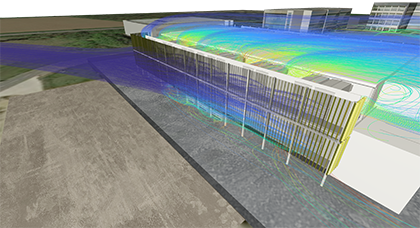Precision Engineered for HPC and AI
Kao Data launched Kao Data London One (KDL1) in 2018. As the UK’s first 100% wholesale multi-tenant data centre to provide 100% free-cooling, the campus is designed to deliver cutting edge and energy efficient colocation services for high performance computing (HPC) artificial intelligence (AI) and enterprise organisations. It offers hyperscale levels of efficiency and a PUE of <1.2, even at partial loads.
Despite its unique and high-performance demands, environmental sustainability is at the heart of KDL1’s design. To ensure greater levels of energy efficiency, the team at Kao Data considered, and ultimately deployed, a refrigerant free Indirect Evaporative Cooling (IEC) system, which uses water evaporation in place of mechanical systems to cool air on hot days.
Future Facilities provided CFD simulations of both the internal and external data centre operating environments to help Kao Data make informed and data-driven decisions around design, implementation, and operations.
Design Parameters and Cooling Methodology
From inception, the Kao Data campus was designed to cater for industrial-scale intensive computing, OCP-Ready™ and GPU-accelerated Supercomputing systems. The campus was split into four data centres totaling roughly 150,000 square feet of technical space. Each facility offers a total technical load of 8.8MW, accommodating rack densities of 25kW – 40kW and beyond.

Above: The effect of the South-Westerly wind on the IEC intakes and exhausts at the south side of the building. Streamlines are coloured by wet-bulb temperature – with the humid exhaust air (orange/yellow) being carried away over the building.
Due to the demanding power and cooling requirements that accompany GPU-intensive systems, it is essential to keep them as energy efficient and sustainable as possible. This requires pinpointing operational efficiency, effective power and cooling systems, and by contracting 100% renewable energy.
Kao Data initially decided to use an Indirect Evaporative Cooling system to meet cooling requirements. IECs use external air to cool the facility, without allowing external and internal airstreams to mix. It is critical in IEC design also to segregate the intake and exhaust of the external air path to avoid moist air being drawn back in.
This is where CFD simulation came into play, specifically with regard to external modelling. To achieve such ambitious design specifications, Kao Data needed to ground its decision making in factual data. Future Facilities’ simulation and CFD software complimented Kao Data’s technical capabilities and helped manage risk and ensure industry-leading levels of efficiency, prior to committing to the build phase of the project.
Digital Twin Enables Optimised Design
Using Future Facilities CFD, Kao Data created a digital twin of their data centre, and by leveraging its market-leading 6SigmaDCX product suite, were able to evaluate the facility's cooling performance under various conditions. This included multiple weather scenarios, operating conditions at full and partial utilisation and different configurations with the external design.

Above: A view demonstrating the relative wet-bulb temperature between the air that enters and leaves the IEC, as a result of adiabatic/evaporative cooling.
Overall, with CFD simulation, Kao Data was able to:
- Evaluate the viability and performance of the proposed IEC design concept
- Confirm satisfactory cooling performance of each of the proposed build-out stages
- Demonstrate the effect of potential variations and extreme environmental conditions
- Verify that predicted IEC inlet conditions for a variety of external conditions were acceptable and should not compromise IEC performance
Ultimately, Kao Data was able to use a CFD simulation study of the external site to understand the thermal performance of the design, as well as how this could be affected by weather conditions and the various stages of site build-out.
“Future Facilities industry-leading reputation for CFD analysis was pivotal in helping us to design and build one of the most sustainable and energy efficient facilities in the UK,” said Paul Finch, Chief Operating Office (COO) Kao Data. “It has helped us refine our decision-making process around the provision of cooling infrastructure and more recently was crucial in the deployment of NVIDIA’s Cambridge-1 supercomputer.”
Today, Kao Data and Future Facilities continue to work together and model complex designs for enterprise, HPC and artificial intelligence customers – a process which helps to maximise both operational and energy efficiency, and deliver a highly sustainable colocation solution.
The full case study, which can be accessed here, details how data centre CFD simulation enabled Kao Data to evaluate its Indirect Evaporative Cooling system and build the UK Innovation Corridor’s home for HPC, AI and industrial-scale, intensive computing.
